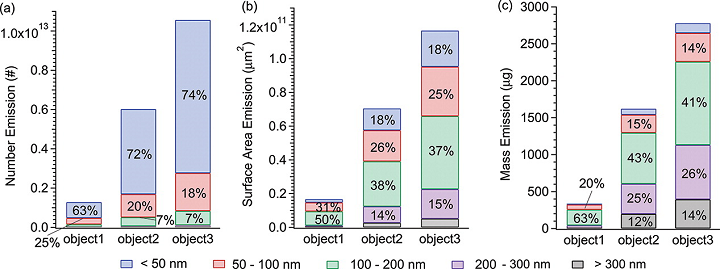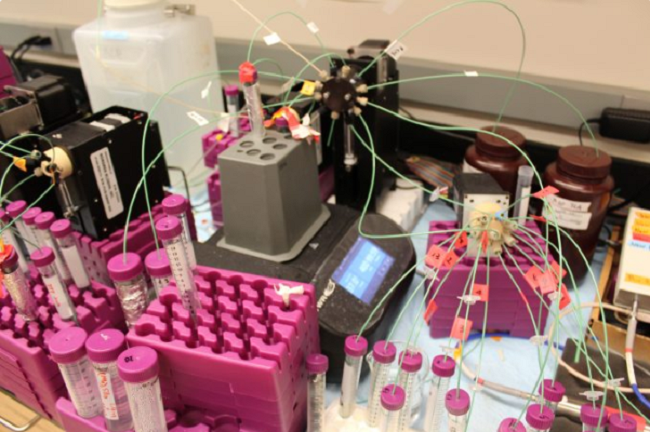America Makes ready for “Game Day” at RAPID 2019
UL and Georgia Tech Continue Research Into Impact of 3D Printing Emissions on Indoor Air Quality
In 2015, non-profit safety science company Underwriters Laboratories (UL) and its Chemical Research Initiative, the Georgia Institute of Technology (Georgia Tech), and Emory University Rollins School of Public Health, worked together to conduct a two-year study on desktop 3D printer emissions. Over the course of the study, Dr. Marilyn Black, the Vice President and Senior Technical Advisor at UL Chemical Safety, and the rest of the research team found that desktop 3D printer emissions can actually pose a potential health threat.
This month, UL Chemical Safety, a science-directed research group that is part of UL, and Georgia Tech released their previous findings, and announced a new body of research that will look into the impact of 3D printing on indoor air quality.
Dr. Black stated, “Following our series of studies – the most extensive to date on 3D printer emissions – we are recommending additional investments in scientific research and product advancement to minimize emissions, and increased user awareness so safety measures can be taken.”
The previous study determined that while many desktop 3D printers are in operation, they generate ul
Additionally, the team’s research showed that over 200 different volatile organic compounds (VOCs), many of which are either suspected or known carcinogens and irritants, are also released into the air while 3D printers are operating.
UL has now begun a dedicated campaign to raise awareness of the potential air quality risks of 3D printing, and to educate users on how to minimize their exposure to VOCs and UFPs. Dr. Black is advocating for a complete risk assessment, which could factor in considerations in personal sensitivity and dosage, in order to more “fully understand the impact of the chemical and particle emissions on health.”
“Studies have shown that fused filament fabrication (FFF) 3D printers designed for general public use emit high levels of ultrafine and fine particles. Preliminary tests with in vivo, in vitro and acellular methods for particles generated by a limited number of filaments showed adverse responses,” explained Dr. Rodney Weber, Georgia Tech’s primary investigator of the research.
 There are plenty of different factors, from filament type and color to nozzle temperature and even the brand of 3D printer, that can affect the level of emissions, and while there are definitely products out there that purport to make 3D printing safer, there isn’t a lot of available marketplace information just yet.
There are plenty of different factors, from filament type and color to nozzle temperature and even the brand of 3D printer, that can affect the level of emissions, and while there are definitely products out there that purport to make 3D printing safer, there isn’t a lot of available marketplace information just yet.
These findings from Georgia Tech and UL come as 3D printing continues to gain momentum in commercial, consumer, educational, medical, and military applications, and if the issue of harmful emission levels is not addressed, there could be a potential public health risk.
3D printers are being used more and more often in school settings, and as children are the most sensitive population to the impact of contaminants such as VOCs, we need to make sure we’re protecting them by reducing their exposure to emissions.
We can lower the potential risks by following some simple rules:
- Operating 3D printers in well-ventilated areas
- Standing away from operating 3D printers
- Setting the nozzle temperature at the lower end of the suggested range
- Using 3D printers and filaments that have been tested and verified to have low emissions
Researchers from UL and Georgia Tech recently published two scientific research papers, titled “Investigating particle emissions and aerosol dynamics from a consumer fused deposition modeling 3D printer with a lognormal moment aerosol model” and “Characterization of particle emissions from consumer fused deposition modeling 3D printers,” in the journal Aerosol Science and Technology. Additionally, two more papers regarding the “plethora of chemical emissions” and 3D printer particle toxicity are currently under review.

Particle number (a), surface area (b) and mass (c) emissions for ABS filament d green color on printer A for 3 objects taking about 1 h, 4 h, and 7 h to print. Each bar indicates the emission (TP) from one print object; colors indicate different particle size ranges. Values on the colored bars are the ratios of emissions from such particle size range over total emissions. [Image: Georgia Tech & UL]
Based on the current research, and further collaboration with third-party stakeholders, a new UL/American National Standards Institute (ANSI) consensus standard has been developed for testing and evaluating 3D printer emissions. UL/ANSI 2904 is currently available for review and comment, and the final standard should be ready next month.
What do you think about this? Discuss this research and other 3D printing topics at 3DPrintBoard.com or share your thoughts in the Facebook comments below.
America Makes and ANSI Publish Latest Version of Standardization Roadmap for Additive Manufacturing
 America Makes, the national accelerator for additive manufacturing and 3D printing based in Youngstown, Ohio, began working with the American National Standards Institute (ANSI), a private non-profit organization, back in early 2016 to develop standards and specifications for the rapidly evolving 3D printing industry. Together, they formed a regulatory institution for the industry, called the America Makes and ANSI Additive Manufacturing Standardization Collaborative (AMSC), and in an effort to facilitate industry growth, immediately got to work developing a roadmap that could be used to identify necessary additive manufacturing standards.
America Makes, the national accelerator for additive manufacturing and 3D printing based in Youngstown, Ohio, began working with the American National Standards Institute (ANSI), a private non-profit organization, back in early 2016 to develop standards and specifications for the rapidly evolving 3D printing industry. Together, they formed a regulatory institution for the industry, called the America Makes and ANSI Additive Manufacturing Standardization Collaborative (AMSC), and in an effort to facilitate industry growth, immediately got to work developing a roadmap that could be used to identify necessary additive manufacturing standards.
The AMSC was specifically chartered to coordinate and speed up the development of industry-wide additive manufacturing standards that are consistent with stakeholders’ needs, along with setting up a possible approach to the future development process. Four working groups in the areas of design, maintenance, process and materials, and qualification and certification began working, and in December of that same year, the AMSC released the preliminary final draft of its Standardization Roadmap for Additive Manufacturing (Version 1.0) to the public for review and comment.
 The completed roadmap was published last February, naming 89 ‘gaps’ – 19 of which were labeled high priority – where no standard or specification had been previously published for a specific industry need. Phase 2 of the project began not long after, and just a few months ago, the AMSC released its preliminary final draft of the Standardization Roadmap for Additive Manufacturing (Version 2.0).
The completed roadmap was published last February, naming 89 ‘gaps’ – 19 of which were labeled high priority – where no standard or specification had been previously published for a specific industry need. Phase 2 of the project began not long after, and just a few months ago, the AMSC released its preliminary final draft of the Standardization Roadmap for Additive Manufacturing (Version 2.0).
The AMSC released the 260-page draft in order to receive public review and comments, and planned for its final publication this June. About 320 individuals, from 175 different public and private sector organizations, supported the development of this second document version.
This week, the group, which receives major funding from the US Department of Defense (DoD), has announced the publication of its completed Standardization Roadmap for Additive Manufacturing (Version 2.0), which is available for download here.
Jim Williams, the President of All Points Additive and Chair of the AMSC, said, “It’s been a privilege to be involved with the committed group of professionals who make up the AMSC and I want to thank all of them who contributed to this undertaking.”
This latest version of the AMSC roadmap offers a description of the existing additive manufacturing standardization landscape, and also lists progress updates on the gaps identified in the first version, many of which have been, as America Makes puts it, “substantially revised.” A total of five gaps have been withdrawn.
Rob Gorham, Executive Director of America Makes, which is driven by the National Center for Defense Manufacturing and Machining (NCDMM), said, “We are extraordinarily pleased at the AMSC’s continued progress to define a coherent set of additive manufacturing standards and specifications that will benefit the industry.”
V2 of the roadmap has identified 93 gaps, of which 18 are listed as high priority, where no specifications or standards have been published to address an industry need. These new gaps include a lot about polymers, including topics such as laser-based additive repair, the use of recycled polymer precursor materials, NDE of polymers and other non-metallic materials, and heat treatment polymers. In a total of 65 of these gaps, the document lists additional pre-standardization R&D needs.
Joe Bhatia, President and CEO of ANSI, said, “Coordination of standards development activity in emerging technology areas is something that ANSI excels at, and we have been very pleased to partner with America Makes to define the standards needed to help grow the additive manufacturing industry.”
The Standardization Roadmap for Additive Manufacturing (Version 2.0) considers the entire life cycle of a 3D printed part in its standards, all the way from the design and selection of the materials and process through production, post-processing, finished material properties, testing, qualification, and even maintenance post-print.
The document reads, “As with the earlier version of this document, the hope is that the roadmap will be broadly adopted by the standards community and that it will facilitate a more coherent and coordinated approach to the future development of standards and specifications for additive manufacturing.
“To that end, it is envisioned that the roadmap will continue to be promoted in the coming year. The roadmap may be updated in the future to assess progress on its implementation and to identify emerging issues that require further discussion.”
This latest roadmap version is supplemented by a listing of standards, titled the AMSC Standards Landscape, which are either peripherally or directly related to the issues laid out in the document. Both this document, Version 2.0 of the roadmap, and additional information are available on the AMSC website.
Discuss this and other 3D printing topics at 3DPrintBoard.com or share your thoughts in the Facebook comments below.





